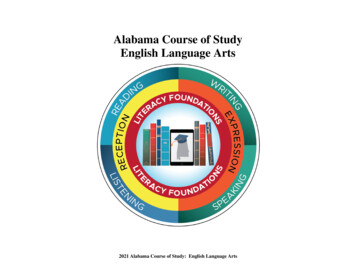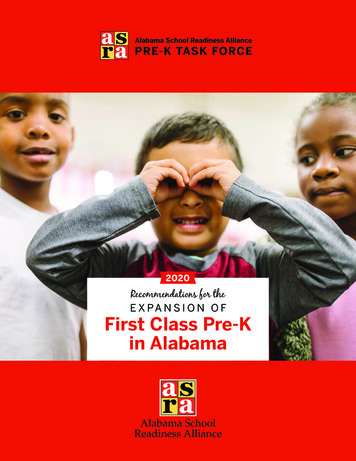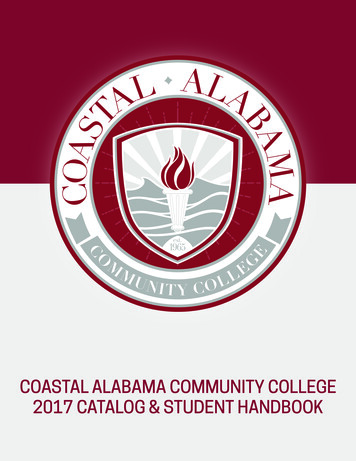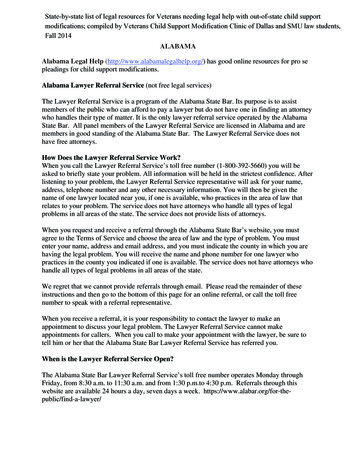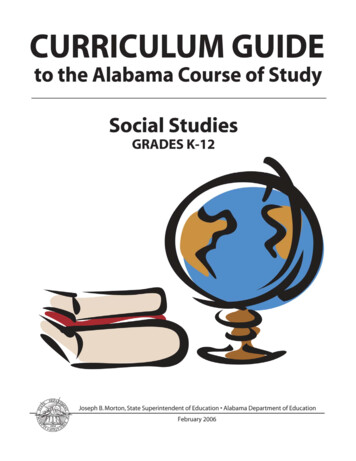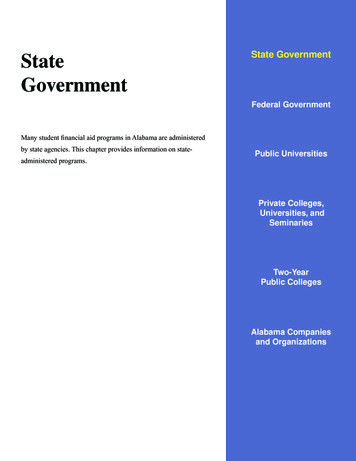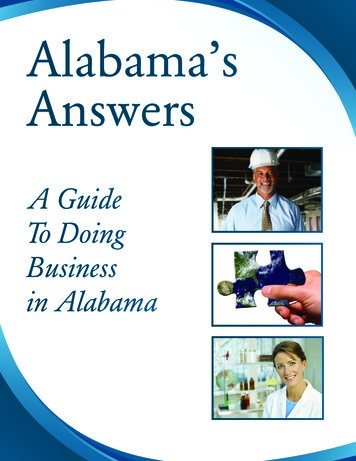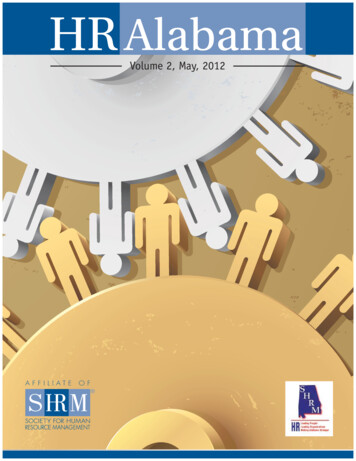
Transcription
For information regarding theAlabama Course of Study: English Language Artsand other curriculum materials,contact the Standards/Courses of Study and Textbooks Section,Alabama State Department of Education,3345 Gordon Persons Building,50 North Ripley Street, Montgomery, Alabama 36104;or by mail to P.O. Box 302101, Montgomery, Alabama 36130-2101;or by telephone at (334) 242-8059.Thomas R. Bice, State Superintendent of EducationAlabama State Department of EducationThe Alabama State Board of Education and the Alabama State Department of Education do not discriminate onthe basis of race, color, disability, sex, religion, national origin, or age in its programs, activities, oremployment and provide equal access to the Boy Scouts and other designated youth groups. The followingperson is responsible for handling inquiries regarding the non-discrimination policies: Title IX Coordinator,Alabama State Department of Education, P.O. Box 302101, Montgomery, AL 36130-2101, telephone (334)242-8165
Alabama Course of StudyEnglish Language ArtsThomas R. BiceState Superintendent of EducationALABAMA STATE DEPARTMENT OF EDUCATION
MEMBERSof theALABAMA STATE BOARDOF EDUCATIONSTATE SUPERINTENDENTOF EDUCATION’S MESSAGEDear Educator:Governor Robert J. BentleyThe 2016 Alabama Course of Study: EnglishLanguage Arts presents a sound curriculumdesigned to prepare students for the Englishlanguage arts demands in both college studies andcareer opportunities. Local school system teachersand administrators will find this document tocontain a challenging set of content standards forstudents at each grade level. I encourage eachsystem to use this document to develop localcurriculum guides that determine how students willachieve these standards and perhaps go beyondthem.Student success depends on local systemleadership, school leadership, and effectiveclassroom instruction. Important local decisionsinclude how students will accomplish thesestandards, in what sequence teachers will addressthem, and how much time will be allotted forinstruction of the standards. These decisions are assignificant as the identification of what studentsneed to know and be able to do.These standards are based on a foundation providedby the 2010 Common Core State Standards forEnglish Language Arts & Literacy inHistory/Social Studies, Science, and TechnicalSubjects and those added from the 2007 AlabamaCourse of Study: English Language Arts by theAlabama English Language Arts State StandardsTask Force. Content knowledge and skillrequirements included in this document aredesigned not only to meet English language artsclassroom expectations but also to enhance studentperformance in other content areas. Literacystandards in the reading and writing strands of thisdocument must be incorporated into literacyacquisition and development in other areas ofinstruction—especially in history/social studies,science, and technical subjects.President of the State Board of EducationDistrictIIITracy RobertsBetty PetersIIIStephanie W. BellIVDr. Yvette RichardsonVElla B. BellPresident Pro TemVIDr. Charles E. ElliottVice PresidentVIIVIIIJeffery NewmanMary Scott HunterState SuperintendentThomas R. BiceSecretary and Executive OfficerThomas R. BiceState Superintendent of Education2016 Revised Alabama Course of Study: English Language Artsii
Alabama Course of Study: English Language ArtsTable of ContentsPREFACE . ivACKNOWLEDGMENTS . vGENERAL INTRODUCTION . 1CONCEPTUAL FRAMEWORK . 4POSITION STATEMENTS . 5HISTORY/SOCIAL STUDIES, SCIENCE, AND TECHNICAL SUBJECTS:NOTES ON RANGE AND CONTENT . 8COLLEGE AND CAREER READINESS ANCHOR STANDARDS FORREADING, WRITING, SPEAKING AND LISTENING, AND LANGUAGE . 9DIRECTIONS FOR INTERPRETING THE MINIMUM REQUIRED CONTENT. 13MINIMUM REQUIRED CONTENTGrades K – 2 Overview . 14Kindergarten . 15Grade 1 . 20Grade 2 . 25Grades 3 – 5 Overview . 31Grade 3 . 32Grade 4 . 38Grade 5 . 44Grades 6 – 8 Overview . 50Grade 6 . 51Grade 7 . 57Grade 8 . 63Grades 9 – 12 Overview . 69Grade 9 . 70Grade 10 . 78Grade 11 . 86Grade 12 . 94APPENDIX A. Research Supporting Key Elements of the Standards . 102Glossary of Key Terms . 103APPENDIX B. Samples of Student Writing . 104APPENDIX C. Literacy Standards for Grades 6-12:History/Social Studies, Science, and Technical Subjects . 105APPENDIX D. 2010 College- and Career-Ready Standards (CCRS): English Language ArtsSkills and Understandings that Require Continued Action . 112APPENDIX E. Alabama High School Graduation Requirements . 113APPENDIX F. Guidelines and Suggestions forLocal Time Requirements and Homework . 114BIBLIOGRAPHY . 1162016 Revised Alabama Course of Study: English Language Artsiii
PREFACEThe 2016 Alabama Course of Study: English Language Arts provides the framework for the K-12 studyof English language arts in Alabama’s public schools. Content standards in this document are minimumand required (Code of Alabama, 1975, §16-35-4), fundamental and specific, but not exhaustive. Thesestandards are based on the 2010 Common Core State Standards for English Language Arts & Literacy inHistory/Social Studies, Science, and Technical Subjects, * a document representing the culmination of anextended effort led by the National Governors Association (NGA) Center for Best Practices and theCouncil of Chief State School Officers (CCSSO). These standards have a great deal of commonalitywith previous standards but raise expectations of student learning in several respects, including requiringmore attention to reading and comprehending informational text and requiring an increased complexityin literary texts studied. When developing local curriculum, school systems may include additionalcontent standards to reflect local philosophies and add implementation guides, resources, and activities.The standards do not define the nature of advanced work for students who meet the standards prior to theend of high school. For those students, advanced work in such areas as literature, composition,language, and journalism should be available to provide the next logical step from the college- andcareer-readiness foundation established here.The 2010 English Language Arts State StandardsTask Force included the Common Core State Standards(CCSS) and additional content from the 2007 Alabama Course of Study: English Language Arts tocreate the Alabama College- and Career-Ready Standards for English Language Arts. Some standardsfrom the CCSS were moved from one grade band to another in the high school grades to align withcontent being studied in Alabama history/social studies courses. Finally, the Task Force reachedunanimous agreement that the standards contained herein provide a sound and challenging Englishlanguage arts curriculum that will prepare Alabama’s students for success in college and careers. Thissame Task Force, along with additional teachers, returned in 2013, 2015, and 2016 to review and updatethe document.*Copyright 2010. National Governors Association Center for Best Practices and Council of Chief State School Officers. All rights reserved.2016 Revised Alabama Course of Study: English Language Artsiv
ACKNOWLEDGMENTSThis document was developed by the 2010 Alabama English Language Arts State Standards Task Forcecomposed of 2007 English Language Arts State Course of Study Committee members andrepresentatives appointed by the Alabama State Board of Education. These members were composed ofearly childhood, intermediate school, middle school, high school, and college educators and selectedbusiness and industry leaders. The Task Force developed the document during the summer of 2010 andsubmitted the document to the Alabama State Board of Education for adoption at the November 2010meeting.2010 Alabama English Language Arts State Standards Task ForceBarbara Hoetker Ash, Ph.D., Assistant Professor, Auburn UniversityElisabeth Davis, School Improvement Specialist, Shelby County Board of EducationLydia B. Davis, Teacher, Indian Valley Elementary School, Sylacauga City Board of EducationDebora B. Grimes, Teacher, Andalusia Elementary School, Andalusia City Board of EducationAndrè L. Harrison, Assistant Superintendent for Human Resources and Instruction, Elmore CountyBoard of EducationShanetta Holman, Teacher, Bruce K. Craig Elementary School, Dallas County Board of EducationDana Jacobson, Teacher, Clay-Chalkville High School, Jefferson County Board of EducationPeggy J. Long, Elementary Collaborative Special Education Coordinator, Huntsville City Board ofEducationSandra Luster, Secondary Literacy Coach, Elmore County Board of EducationMichelle S. Miskelley, Teacher, Paine Primary School, Trussville City Board of EducationMaxine Pijeaux, Ph.D., Assistant Superintendent, Birmingham City Board of EducationDebra D. Royston, Teacher, Handley Middle School, Roanoke City Board of EducationJanet Thomas Sullen, Teacher, Booker T. Washington High School, Macon County Board of EducationAnnette M. Tate, Teacher, Benjamin Russell High School, Alexander City Board of EducationSharon Underwood-Malone, Teacher, Emma Sansom Middle School, Gadsden City Board ofEducationRomelle Vaughn, Teacher, Elsie Collier Elementary School, Mobile County Board of EducationState Department of Education personnel who managed the development process were:Thomas R. Bice, Ed.D., Deputy State Superintendent of Education;Feagin Johnson, Jr., Assistant State Superintendent of Education;Cynthia C. Brown, Director, Standards/Courses of Study and Textbooks; andSusan B. Davis, Ed.D., Administrator, State Courses of Study Committees, Standards/Courses of Studyand Textbooks.2016 Revised Alabama Course of Study: English Language Artsv
The State Department of Education program specialist who assisted the Task Force in developing thedocument was:J. Steve McAliley, English Language Arts Specialist, Standards/Courses of Study and Textbooks.The State Department of Education process specialists who assisted the Task Force in developing thedocument were:Reeda Betts, Education Administrator, Alabama Reading Initiative;Kanetra C. Germany, Education Specialist, Student Assessment;Martha B. Lockett, Education Specialist, Standards/Courses of Study and Textbooks;Nettie Carson-Mullins, Education Specialist, Standards/Courses of Study and Textbooks;Phyllis W. Rase, Education Specialist, Standards/Courses of Study and Textbooks;Judy Stone, Education Administrator, Alabama Reading Initiative; andCarolyn E. Townsend, Education Specialist, Standards/Courses of Study and Textbooks.Natasha D. Sims, Administrative Support Assistant, Standards/Courses of Study and Textbooks; andJacqueline L. Perdue, former Administrative Assistant, Standards/Courses of Study and Textbooks,assisted with the preparation of the document.Charles V. Creel, Graphic Arts Specialist, Communication Section, assisted in the development of thegraphic design.Susan J. Blankenship, Education Specialist (retired), Alabama Department of Education, edited andproofread the document.The 2010 Alabama Course of Study: English Language Arts was reviewed and updated in January 2013,October 2013, January 2015 and again in January 2016.2016 Revised Alabama Course of Study: English Language Artsvi
ALABAMA’S K-12 ENGLISH LANGUAGE ARTS CURRICULUMGENERAL INTRODUCTIONThe 2016 Alabama Course of Study: English Language Arts is based upon the culmination of anextensive, broad-based national effort to fulfill the charge issued by the states to create the nextgeneration of Grades K-12 English language arts academic standards. These standards are intended tohelp ensure that all students are college and career ready in literacy no later than the end of high school.Alabama standards are based on work led by the Council of Chief State School Officers (CCSSO) andthe National Governors Association (NGA) and build on the foundation laid by states in their decadeslong work on crafting high-quality education standards. The standards also draw on the most importantinternational models as well as research and input from numerous sources, including state departments ofeducation, scholars, assessment developers, professional organizations, educators from kindergartenthrough college, and parents, students, and other members of the public. In their design and content,refined through successive drafts and numerous rounds of feedback, the standards represent a synthesisof the best elements of standards-related work to date and an important advance over previous work.As specified by the CCSSO and the NGA, the standards are (1) research and evidence based, (2) alignedwith college and work expectations, (3) rigorous, and (4) internationally benchmarked. A particularstandard was included in the document only when the best available evidence indicated that its masterywas essential for college and career readiness in a twenty-first-century, globally competitive society.The standards are intended to be a living work: as new and better evidence emerges, the standards willbe revised accordingly. The standards are an extension of a prior initiative led by the CCSSO and theNGA to develop College and Career Readiness (CCR) standards in reading, writing, speaking, listening,and language as well as in mathematics. The CCR Reading, Writing, and Speaking and ListeningStandards, released in draft form in September 2009, serve, in revised form, as the backbone for thepresent document. Grade-specific K-12 standards in reading, writing, speaking, listening, and languagetranslate the broad (and, for the earliest grades, seemingly distant) aims of the CCR standards into ageand attainment-appropriate terms.The standards set requirements not only for English language arts (ELA) but also for literacy inhistory/social studies, science, and technical subjects. Just as students must learn to read, write, speak,listen, and use language effectively in a variety of content areas, so too must the standards specify theliteracy skills and understandings required for college and career readiness in multiple disciplines.Literacy standards for Grade 6 and above are predicated on teachers of ELA, history/social studies,science, and technical subjects using their content-area expertise to help students meet the particularchallenges of reading, writing, speaking, listening, and language in their respective fields. It is importantto note that the Grades 6-12 literacy standards in history/social studies, science, and technical subjectsare not meant to replace content standards in those areas but rather to supplement them. Alabamacurrently incorporates many of these standards into the standards for those subjects; however, futurecourse of study committees may consider adopting them as content-area literacy standards.As a natural outgrowth of meeting the charge to define college and career readiness, the standards alsolay out a vision of what it means to be a literate person in the twenty-first century. Indeed, the skills andunderstandings students are expected to demonstrate have wide applicability outside the classroom orworkplace. Students who meet the standards readily undertake the close, attentive reading that is at theheart of understanding and enjoying complex works of literature. They habitually perform the criticalreading necessary to pick carefully through the staggering amount of information available today in print2016 Revised Alabama Course of Study: English Language Arts1
and digital formats. They actively seek the wide, deep, and thoughtful engagement with high-qualityliterary and informational texts that builds knowledge, enlarges experience, and broadens worldviews.They reflexively demonstrate the cogent reasoning and use of evidence that is essential to both privatedeliberation and responsible citizenship in a democratic republic. In short, students who meet thestandards develop the skills in reading, writing, speaking, and listening that are the foundation for anycreative and purposeful expression in language.2016 Revised Alabama Course of Study: English Language Arts2
2016 Revised Alabama Course of Study: English Language Arts3
ALABAMA’S K-12 ENGLISH LANGUAGE ARTS CURRICULUMCONCEPTUAL FRAMEWORKThe goal of the Alabama English language arts curriculum, represented on the banner at the top of thepreceding page, is for all students to achieve English language literacy in order to be college and careerready. This is accomplished through a sequential, comprehensive curriculum that develops lifelong,critical thinkers who approach problem solving with confidence.The academic content standards in this course of study are based on and include the standards in the2010 Common Core State Standards for English Language Arts & Literacy in History/Social Studies,Science, and Technical Subjects as well as supplemental content designed to strengthen the standards forAlabama’s students. The standards are organized through the strands of Reading Foundations in GradesK-5, Reading Literature, Reading Informational Text, Writing, Speaking and Listening, and Language.Each of these strands is represented by a piece of the puzzle that forms the shape of the state of Alabama.Content standards in all strands must be mastered in order for Alabama’s students to achieve the goal ofEnglish language literacy.Although the standards are presented in separate strands, they are as interrelated as are the pieces of thepuzzle. No strand stands alone; all strands are necessary and depend on each other and must beconnected in classroom instruction in order for students to become college and career ready. Readingfoundations are established during the first six years of school; all other strands are addressed in eachgrade, K-12, as concepts and skills increase in rigor across the grades. Reading Foundations includesthe wide range of processes from early recognition that letters and combinations of letters representsounds to the more complex knowledge of roots and affixes, use of context clues, and fluent reading withaccuracy and expression. Reading Literature standards range from the ability in the early grades toretell stories with key details and describe characters and settings to the ability in senior high grades tosupport analysis of how a theme develops over the course of a text. Standards in the ReadingInformational Text strand are of equal importance to those in the Reading Literature strand and areessential to developing skills students use throughout their years in school and careers. Many standardsare identical to literature standards but must be applied to informational text in each grade. Writingstandards are demanding even in the early grades and present clear and specific expectations for opinionpieces, informative or explanatory text, and narrative text. Shared research projects and use of digitaltools are important elements in this strand throughout the grades. Speaking and Listening standardsrequire students to collaborate for both comprehension and presentation. Preparation for discussions isemphasized across the grades, as is following agreed-upon rules. Students learn to adapt speech to avariety of contexts and tasks, which they apply in all subject areas and life endeavors. Standardsincluded in the Language strand require early understanding and application of the conventions ofStandard English, with specific increasing expectations listed at each grade level. Knowledge oflanguage and its conventions is applied to writing, speaking, reading, and listening. Vocabularydevelopment also receives continuing emphasis in the language strand.The foundation of skills and knowledge in the K-12 English language arts curriculum should prepare allstudents to function as highly skilled communicators for personal and academic needs in elementary,middle, and high school as well as at the college and career level. With this important foundation,Alabama students can achieve the goal of English language literacy.2016 Revised Alabama Course of Study: English Language Arts4
POSITION STATEMENTSAppreciation of Literature and Enjoyment of ReadingIt is important for teachers to provide students with a variety of authentic texts, allow students to selfselect some of their reading materials, and increase efforts to inspire within students a genuine love ofreading. In addition, efforts should be made to increase the quantity of reading to help students expandtheir reading abilities and bring them into regular contact with new words, sentence structures, andparagraph and story structures.To help students cultivate a love for reading and an appreciation of literature, teachers should providestudents with opportunities for sustained silent reading of student-selected, high-interest readingmaterials. Such opportunities allow students to naturally develop increased reading fluency andcomprehension. However, self-selection of reading materials is not intended to replace direct instructionon assigned or more challenging reading selections. Direct instruction in reading strategies does notdetract from reading enjoyment; rather it increases the pleasure that may be gained from readingliterature. Substantial amounts of reading time in the classroom should be spent providing instruction incomprehension strategies such as identifying main idea, making inferences, identifying author purpose,distinguishing fact and opinion, summarizing, predicting, and questioning.FluencyFluency is one of the five essential components of reading instruction. Fluency involves both thenumber of words read per minute and the ability to read with expression. Reading with expressionincludes combining words in phrases and clauses and pausing appropriately for commas and endpunctuation. For most readers, fluent reading requires practice and instruction and cannot occur whenstudents are reading text with many unfamiliar words. Teachers and other competent readers shouldmodel fluent reading with material at the student’s independent reading level and then have the studentread the same passage orally. To achieve reading fluency, several important strategies should beemployed as part of reading instruction: Allow for repeated readings,Provide explanations of why certain words are grouped and connected,Provide explanations of why pauses are appropriate at certain places,Utilize high-interest poetry and story reading materials,Allow for reading of quantities of materials without paying special attention to quality, andEncourage use of decoding skills to aid in word recognition.Differentiated Instruction and English Language LearnersProviding differentiated instruction is not only for English language learners (ELLs), nor for strugglingreaders or students with special needs, but for all students. Teachers are able to differentiate content,process, and product based upon the fact that learners differ in readiness, interests, and learning styles.Ongoing and diagnostic assessment is at the core of differentiated instruction. All students are able tolearn—just not in the same way.2016 Revised Alabama Course of Study: English Language Arts5
An increasing number of students in today’s classrooms come from culturally and linguistically diversebackgrounds and have limited English proficiency. These students are not a homogeneous group ofstudents learning English. Personal, cultural, and educational backgrounds differ significantly and,therefore, require instruction that meets their particular needs.ELLs require instruction that makes content comprehensible, which accelerates acquisition of academiclanguage proficiency. Appropriate instructional support should include access to literature in thestudent’s heritage language for classroom and homework assignments, integration of multiculturalliterature and availability of bilingual books, meaningful hands-on activities that contextualize abstractconcepts, and use of the heritage language in writing and speaking activities. Instructional strategiesshould be adjusted as language proficiency increases.ELLs must simultaneously learn English as a new language and the content area of English languagearts. The World-class Instructional Design and Assessment Consortium’s English Language ProficiencyStandards (WIDA ELP Standards) can assist English language arts teachers in Alabama in designinglanguage development objectives that support and develop the English language and content knowledgeand skills at the appropriate level of English proficiency. By reviewing the sample language objectivesor model performance indicators (MPIs), language arts and reading teachers can determine reasonablelearning expectations for ELLs.TechnologyTechnology significantly enhances the curriculum and engages students actively in the learning processand therefore should be an integral part of the English language arts classroom. Furthermore, technologyallows teachers the opportunity to extend learning experiences beyond the textbook to the realm ofprimary sources and alternate methods of instruction by appealing to various student learning styles.Teachers must incorporate progressive technological tools that interest and motivate students to use theEnglish language for both construction of meaning and creative expression. Because access to everchanging technology varies across the state, standards in this document are not dependent on a particulartechnology, but may be met through available local resources. Nonetheless, providing teachers withcurrent technology is highly recommended if students are to have increased opportunities to developliteracy levels sufficient to meet the demands of the twenty-first century.Technological equipment and resources available for teacher and student use include, but are not limitedto, overhead projectors, televisions, tape recorders, video cassette recorders (VCRs), digital video disk(DVD) players, computers, software programs, videoconferencing, e-mail, sound mixers, videorecording and editing equipment, and digital cameras. Technology enhances the effectiveness ofinstruction, but does not replace the teacher. Teachers model and emphasize ways for students to useand manage technological equipment and resources. From essay writing and research to reading andassessment, instruction that incorporates multiple ways for obtaining information and enhancingexpression serves to prepare Alabama’s students to achieve excellence in English language literacy.Students employ techn
The 2016 Alabama Course of Study: English Language Arts provides the framework for the K -12 study of English language arts in Alabama's public schools. Content standards in this document are minimum and required (Code of Alabama, 1975, §16- 35-4), fundamental and specific, but not exhaustive.These standards are based on the 2010 Common Core State Standards for English Language Arts .
